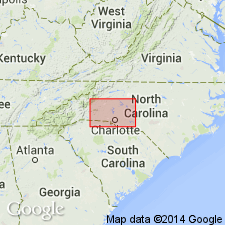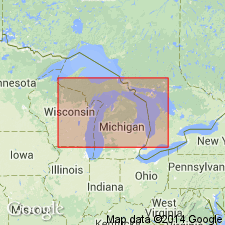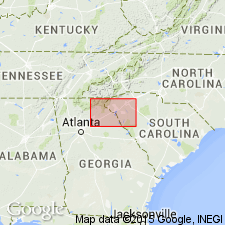
- Usage in publication:
-
- Concord Plutonic Suite*
- Modifications:
-
- Named
- Dominant lithology:
-
- Gabbro
- Syenite
- Diabase
- AAPG geologic province:
-
- Piedmont-Blue Ridge province
Summary:
Syntectonic gabbro, syenite, and metadiabase plutons in the Charlotte belt, NC and SC, informally named the Concord plutonic group by J.R. Butler (1978, U.S. Dept. Energy, GJBX-40(78), plate 1A), are here named the Concord Plutonic Suite. Comprises the named Concord, Farmington, Linwood, Barber, Bear Poplar, Mecklenburg, Pineville, and Weddington plutons (Butler and Ragland, 1969, Contr. Mineralogy and Petrology, v. 24, p. 164-190) and other small intrusive bodies in Cabarrus, Davie, Iredell, Rowan, and Mecklenburg Cos., NC, and Lancaster and York Cos., SC. Major rock types are gabbro, norite, and hornblende gabbro; coarse-grained, gray augite syenite and biotite-hornblende syenite; and fine- to medium-grained undeformed metadiabase. Age is Silurian and Devonian, based on 40Ar-39Ar age spectra plateau dates on hornblende, of 406+/-4 Ma (Farmington pluton) and 408+/-1 Ma (Weddington pluton).
Source: GNU records (USGS DDS-6; Reston GNULEX).

- Usage in publication:
-
- Concord Gabbro
- Concord Syenite
- Modifications:
-
- Geochronologic dating
- AAPG geologic province:
-
- Piedmont-Blue Ridge province
Summary:
Pg. 4, geologic time scale (inside front cover). Concord Gabbro or Concord Syenite. Gabbro sample from south side of country road no. 1300, adjacent to Millard Branch, Lat. 35 deg. 20 min. 02 sec. N., Long. 80 deg. 40 min. 04 sec. W., Harrisburg 7.5-min quadrangle, Cabarrus County, North Carolina, yielded a K-Ar age of 391 +/-16 Ma (biotite). Had been dated at 404 +/-21 Ma (Rb-Sr, whole-rock). Age calculated using decay constants of Steiger and Jager, 1977 (Earth Planet. Sci. Letters, v. 36, p. 359-362). [Silurian to Devonian; Silurian-Devonian boundary 405 (415-405) Ma]
Source: Publication.

- Usage in publication:
-
- Concord Plutonic Suite*
- Modifications:
-
- Revised
- AAPG geologic province:
-
- Piedmont-Blue Ridge province
Summary:
Concord Plutonic Suite includes syenite (previously included in Mount Carmel complex of Griffin, 1978), pyroxenite (previously included in Calhoun Falls complex of Griffin, 1978), undivided gabbro and syenite (previously included in Trotters Shoals complex of Griffin, 1978), and hornblende gabbro (previously included in Abbeville, Calhoun Falls, and Mount Carmel complexes of Griffin, 1978).
Source: GNU records (USGS DDS-6; Reston GNULEX).
For more information, please contact Nancy Stamm, Geologic Names Committee Secretary.
Asterisk (*) indicates published by U.S. Geological Survey authors.
"No current usage" (†) implies that a name has been abandoned or has fallen into disuse. Former usage and, if known, replacement name given in parentheses ( ).
Slash (/) indicates name conflicts with nomenclatural guidelines (CSN, 1933; ACSN, 1961, 1970; NACSN, 1983, 2005, 2021). May be explained within brackets ([ ]).

